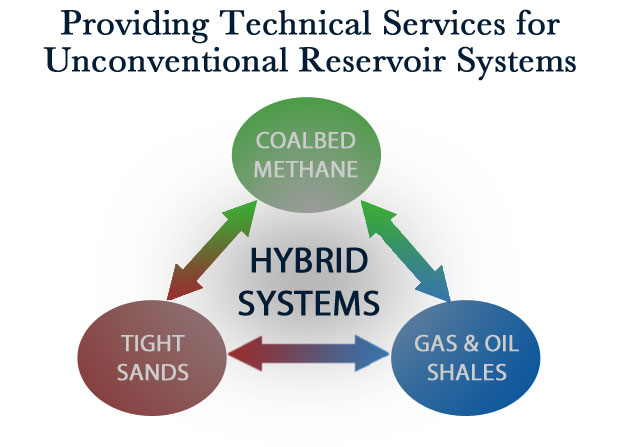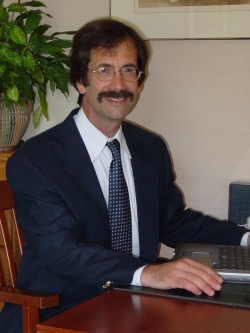a

Past clients include:
Research is to see what everybody else has seen, and to think what nobody else has thought.
This quotation has guided my approach to science and technology long before I heard the words. Throughout my career I have tried to look at things in new and different ways, an endeavor that has yielded many rewards.
The following significant innovations in the understanding of sorbed gas reservoir systems are all original to me, to the best of my knowledge, except where I indicate the work was done in collaboration with colleagues:
with staff of U.S. Bureau of Mines, conceived, designed, and built a hermetically sealed ball mill for comminution of coal samples to quickly release residual gas.
discovered that some of the Cretaceous Fruitland coal in the San Juan Basin was oil-prone, and generated substantial proportion of oil during coalification, which substantially influenced its reservoir characteristics, including suppression of methane sorption capacity due to “plugging” of microporosity.
designed and contructed laboratory equipment for measuring microstrain in an unconfined sample at high pressure, in response to sorption of methane and carbon dioxide, to assess the quantitative effect of matrix shrinkage on coal seam permeability
with Tang Yalan, discovered and documented via optical microscopy and scanning electron microscopy the existence of secondary porosity in coal, which formed in response to coalification; developed methodology for comparison of images in optical microscope and SEM (Secondary porosity has recently been identified as a critical variable in the transmission of gas through shales at high rank.)
designed and constructed laboratory equipment for successfully measuring sorption of methane and carbon dioxide using an electromicrobalance.
under contract to Shell, discovered that unusual linear isotherm shape of sample of Antrim shale was likely due to solvation rather than adsorption, suggesting that there are two mechanisms of sorption in coal and shale, which act in combination to produce a net total sorption capacity
recognized that carbonaceous shales will contribute substantially to in place gas resources in CBM reservoir systems, and developed a methodology for its estimation
for PetroCanada, discovered that elevated gas yields from samples of Cretaceous Mannville coals was likely due to the presence of a free gas phase.
with Whitney Telle, under contract to River Gas, through log and sample analysis, discovered that unexpectedly high productivity of CBM wells in the Black Warrior Basin was likely due to contributions from carbonaceous shales and thin coals associated with the main coal seam, resulting in a 30{5f5f0a671acf0b508101152deea4afb81c8dccec707e26097793c0a640d6907c} increase in predicted gas-in-place, and producible reserves.
with Philip Malone, developed a mathematical extrapolation to predict the quantity of “residual gas” remaining at the termination of gas desorption test.
designed a modification to canister design and test procedure for Gas Content Test, that enabled quick, efficient purge of canister head space with helium, allowing estimation of sample bulk density prior to termination of measurements.
designed a method for collecting a small, uncontaminated sample of gas from canister head space for chromatographic analysis, without requiring positive canister pressure, and without substantially influencing gas volume measurements.
developed a procedure based on geophysical log analysis for classification of petrofacies into categories based on organic matter content, and calculating an integrated total gas resource that includes all organic matter-bearing lithologies.
developed novel methodology for calculation of gas resources over large areas at a range of depths, based upon empirical relationships among variables, and using grid multiplication.
with technical staff at WellDog, recognized that the initiation desorption, and therefore the initiation of “lost gas” in core recovery occurs at the “critical desorption pressure” (a.k.a. “bubble point pressure”) at a particular depth below the surface.
with technical staff at WellDog, recognized that transition from sorbed phase to gas phase causes expulsion of liquid from reservoir matrix, thus explaining excessive water production of CBM wells in the Powder River Basin. The same mechanism probably causes expulsion of liquid petroleum from oil shales.
substantially improved the methodology for estimation of parameters used in stochastic modeling of gas resources for stratigraphic sequences containing multiple coalseams over a substantial stratigraphic interval, including developing predictive empirical relationships among parameters.
developed a substantially improved methodology for calculation of gas resources to be used in heterogeneous reservoirs comprising both coal and carbonaceous shale, including both free gas and sorbed gas in a single resource equation.

Jeffrey R. Levine
Jeff Levine is a consultant geologist, specializing in assessment of coal gas (CBM) and shale gas reservoirs. Jeff holds degrees in geology from the University of Michigan (B.S., 1974) and Penn State (M.S., 1981 and Ph.D. 1983).
Jeff began his professional career in 1974 at the U.S. Bureau of Mines, which was conducting pioneering R&D work on CBM as a mining hazard and as a potential energy resource. While at the Bureau, he participated in development of the “Direct Method” procedure for estimating the in situ gas content of coal, as well as CBM resource assessments in the Pennsylvania Anthracite region, San Juan, and Raton basins. Jeff pursued graduate studies in geology at Penn State, with a major emphasis in coal, structural geology, and tectonics. After completing a two-year post-doctoral fellowship at McGill University (Montréal), he returned to R&D work on CBM at the University of Alabama from 1985-1992. In the ensuing years, Dr. Levine has worked in the natural gas industry, both as an employee and consultant, working for GeoMet Operating Company and CDX Gas.
Since 2002 he has been an independent consultant, based in Richardson, TX. Over the course of his career, he has worked in most of the major coal and shale basins in the United States and Canada, as well as projects overseas, in the UK, Poland, China, Australia, and Colombia. Dr. Levine has taught industry short courses on sorbed gas reservoirs at many venues around the world, and has authored numerous technical papers and talks. He has served as President and Editor of The Society for Organic Petrology, and is active in the Energy Minerals Division of AAPG.